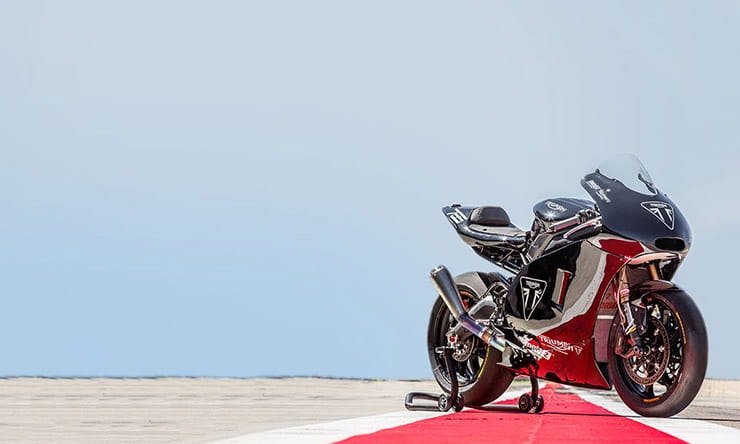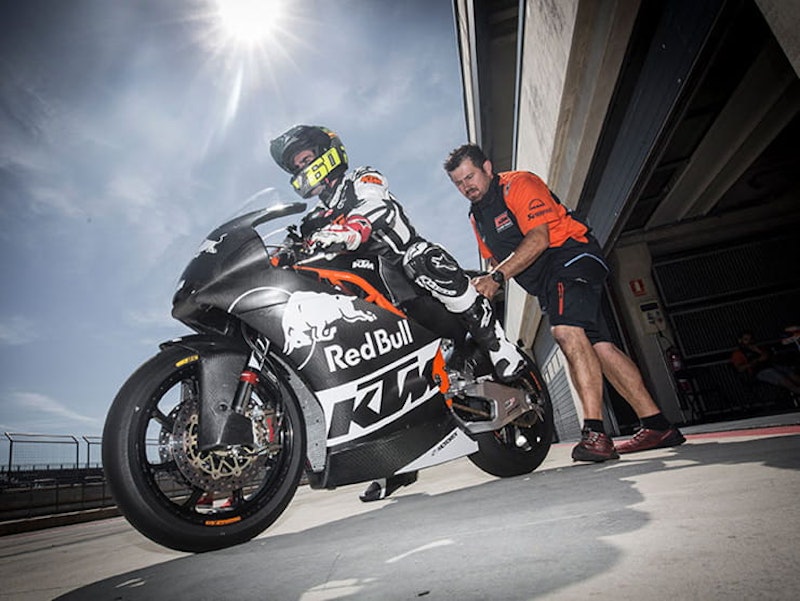Triumph on their Moto2 engine testing and Daytona 765 chances
By Michael Mann
BikeSocial Managing Editor
03.08.2018
After Triumph let us ride their Moto2 test mule up the hill at Goodwood we talk to the main men behind the project and find out just what differences there are, how testing has gone, what Alex Marquez thinks and the chances of a Daytona 765 in the future.
The gulf between Moto3 and MotoGP is already big enough; 250cc vs 1,000cc and the insane power gap aside, the natural progression up the ranks would have been via the intermediate class, Moto2. But that’s proving more difficult as the seasons pass and the stiff chassis bikes powered by the Honda 600cc motor get harder to ride quickly. I’m sure British trio Tarran Mackenzie, Sam Lowes and Danny Kent will testify.
So, when Triumph announced a deal with Dorna, the MotoGP commercial rights holders, to supply a 765cc in-line three-cylinder motor from 2019 for an initial term of three years, replacing the screaming Honda’s after nine seasons, the way in which the Triumph version delivers its power and torque looks set to benefit riders and fans alike.
Now, some 14 months since the announcement, the official test mule features a developed Daytona 675 frame, a ‘race-ready’ Moto2 Triumph engine and the additional components now featuring as it heads into its final development stages including a Magneti Marelli ECU, the pieces of the puzzle are coming together. A schedule of rigorous testing has taken place mainly by ex-125GP World Champion and Moto2 runner-up, Julian Simon, who has subsequently (and rather craftily) been signed up by KTM as their chassis tester ahead of the 2019 season. Other than Simon, only a handful of racers have ridden the bike in anger.
In March of next year when Round One takes place in Qatar and the cacophony of 30+ 765 triples hurtling towards turn one is going to be a glorious assault on every spectator’s ears.
Chief Triumph tester, Julian Simon, has also been snapped up by KTM
To tell us more about how the deal came about, the differences between the Street Triple engine and the Moto2 power plant and the feedback from the riders that have tested it, we spoke to Triumph’s Chief Product Officer, Steve Sargent:
What are the most recent developments with the bike and the engine?
The engine has changed quite a lot recently – we’ve increased the compression ratio, increased in the rpm up to 14,000rpm and it now has the latest ECU and a full Moto2 fairing.
The ECU gives the teams a lot of choice to make changes with ignition, fuelling, engine breaking, electronic throttle maps, quick shifter adjustments and pit lane speed limiters. Next year will be much closer to MotoGP levels of technology than Moto2 has ever been. The class is going to become really interesting, with exciting racing and even more competition between team engineers to develop the best-performing package.
I heard the term ‘Race Ready’ so does that mean the engine is good to go?
In terms of a production bike engine there’s things you have to do to make it more suitable for racing so there are things we have done to give the Moto2 engine more power and more torque than the standard bike. We’ve changed the flow on the cylinder head, we’ve made changes to the ports, we’ve put titanium valves in there, we’ve put race valve springs in there. That helps the bike to spin faster, produce more power at the top end and to reduce inertia out of the engine, including things like putting a race alternator on there. We’ve changed the gear ratios so that first and second gear ratios are different from the standard bike. The clutch is completely different, it’s a full SCC race clutch on there. So, there’s quite a lot of internal changes to the engine, it’s heavily based on the Street Triple 765 engine but the modifications are there to give that little bit more for the Moto2.
Ready for testing at Aragon
How did the deal as a Moto2 engine supplier evolve?
It all started over 18 months ago when I was chatting to a guy who used to work for Triumph who has been involved with some race teams since. He remains a good friend and we were chatting about other projects when he told me the contract was coming up for renewal on Moto2. He knew that Dorna were looking for something a little bit different, something with a little more power and that if we were interested he’d put us in touch with the right people.
So, we started discussions about what they were looking for and what we had in development that might be of interest to them. And the two things coincided. What they were looking for was almost exactly what we had planned anyway!
It’s an amazing opportunity for us to put the Triumph brand out there to put it in front of people that already know about Triumph but also to those who are less familiar with Triumph. A good thing about MotoGP and Moto2 is that it attracts quite a youthful audience, a lot of younger motorcyclists who are into MotoGP and who watch it every weekend, so the opportunity for us to get the Triumph brand and that engine in front of them is one that we couldn’t pass up.
The initial term of the deal is three years with an option to renew for another three years.
Naturally, we’re all assuming and hoping to see a Daytona 765 road bike as a result of this project. Can you confirm anything?
As we’ve said all along, as soon as we spoke about going into Moto2, straightaway people were saying, “surely that means you’re going to update the Daytona” and that was never going to be an inevitability. What we’ve always said is that “if there’s enough demand for one then we’d consider doing it”. You know as well as I do that middleweight sports market has shrunk massively over the last year or so, so it’s always a challenge to say “yeah we can do the bike, but actually is there enough demand out there to do it, and that’s something we’re continuing to watch.”
What are the differences between the Honda and the Triumph engines?
What the riders will experience is strong torque throughout the rev range and that’ll give them quite a bit more punch coming out of the corners. At the recent Aragon test, people like Alex Marquez (currently 3rd in the Moto2 World Championship) were saying, “with this engine in the bike you have to ride it a lot more like a MotoGP bike than the current Moto2 bikes.” With the Honda you have to carry a lot of corner speed whereas with the Triumph in there, it’s a question of getting it in there, getting it turned and getting back on the fat part of the tyre and using the torque of the engine to accelerate out.
For me personally and for Triumph that feedback is fantastic to hear. That was Dorna’s ambition from the start; to get the Moto2 class to move a lot closer to MotoGP. That’s why they’ve brought a lot more adjustability into the electronics package as well because it’s not just a question of the riders getting that experience of something that’s a bit closer to MotoGP, it’s also the teams and the technicians having the ability to learn something in Moto2 that is relevant when they move up to MotoGP.
What happens once the engines have been delivered?
Where we are now, the mechanics of the engine are developed to a point where we’re happy with it. The ongoing development from now until the start of next season is really on the electronics package so we’re working closely with Magnetti Morelli on the ECU and we’ve got other tests line up where we’ll take that on further following the feedback we’ve had recently. But in terms of the engine components themselves, they’re now fixed for the season but if we want make changes after that first season that’ll be a discussion between ourselves and Dorna.
The heartbeat of Moto2 from 2019 onwards
Triumph’s Head of Brand Management, Miles Perkins, explains how testing has been going:
The engine development in terms of Dorna sits with the responsibility of ExternPro – the party who build from the kits the engines to provide to the teams on a race weekend. And as you know the teams don’t get to keep those engines.
And what happened in Aragon on the 19th June was the sort-of beginning of the final phase, which was the chassis testing for the three teams who were present. So, they’ve now got the final engine and the final development ECU, although it is still being refined with Magnetti Morelli. Each of the three teams at the test, Kalex, KTM and NTS were putting out for the very first time their prototype chassis. So, they were looking at engine set-up and chassis set-up from the rider’s perspective.
The Kalex was ridden by Alex Marquez and test rider Jesko Raffin, the KTM by Julian Simon and Ricky Cardus while the NTS had Alex de Angelis on board.
What we were hearing back from the teams is that the power delivery is much more like a MotoGP bike than the current Moto2 bike. ExternPro quoted that this was ‘positively in line with their expectations’ because as a feeder series for MotoGP, those in Moto2 who win the championship or who are doing very well are looking to get into MotoGP, so the fact that the power delivery is very similar is considered a progressive step for the engine.
Remember this was the very first shake-down test and no lap times were officially published but what was really reassuring was that after two days of testing, the current lap times for Aragon were being hit. We took that as very good news and certainly we were seeing very progressive results since Julian Simon has been testing the bike over the year and a half.
We’re very much looking forward to seeing our baby in action and we’re looking to be present at as many rounds as possible to host Triumph fans with a pit-garage style set-up.
Our man Mann got his mitts on the Triumph mule at Goodwood Festival of Speed recently
Share on social media:

